IDP News Issue No. 12
The Stein Collection in the British Library
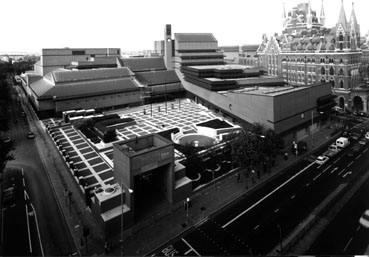
Left:The new British Library building, built next to the neo-Gothic St.Pancras railway station (seen in right of picture), was completed in 1996 and houses nearly 12 million volumes in four levels of basements. Photograph by Irene Rhoden.
Having introduced the major collections of Dunhuang manuscripts in the National Library of China, Beijing (IDP News6, November 1996), The Institute of Oriental Studies, St Petersburg (IDP News2, January 1995), and the Bibliothèque nationale de France, Paris (IDP News 4, January1996) , as well as private and public collections in Japan (IDP News10, Spring 1998) and manuscripts from Turfan in the Staatsbibliothek, Berlin (IDP News 3, July 1995), this issue concentrates on the last large collection, that at the British Library, as well as giving a report on three collections in Taipei. The next few editions of the newsletter will introduce smaller collections worldwide. A listing will be added to the IDP web pages bringing all this information together later this year.
Collection History
The British Library's Stein collections have a complicated history resulting from the economics of exploration and the division of artefacts collected by Stein on his first three Central Asian expeditions to Chinese Turkestan. Financial support offered by the Trustees of the British Museum and by the Government of India was acknowledged in a division of his finds made largely on the basis of language, style and type. All the material was first sent back to London for division between the British Museum (various departments) and the Government of India. The latter materials were divided between the National Museum in Delhi (3D materials, wall-paintings and some graphic works), and the India Office Library (textual materials, mainly in Sanskrit and Tibetan). The division, particularly of textual material, was further complicated by the fact that many documents had inscriptions in different languages on recto and verso. When the British Library was founded in 1973, textual material from the Stein collection mainly in Chinese but including documents in Tibetan, Sanskrit, Kharoshti script, Khotanese, Uighur and Turkic was transferred from the British Museum's Department of Oriental Manuscripts and Printed Books. In 1982, the India Office Library (IOL) was transferred from the Foreign and Commonwealth Office to the British Library, joining the Oriental Collections (Or.) to form the Oriental and India Office Collections. The transfer included collections of materials mainly in Tibetan and Sanskrit but also including some Chinese, Khotanese and Kharoshti script material, collected on Stein's first three Central Asian expeditions which had been lodged with the India Office. The collections are therefore numbered with the prefix 'Or.' or 'IOL' to show their origin. Within the 'IOL' prefix, they are categorised according to language (IOL San, IOL Khot, IOL Tib etc.), and within the 'Or' prefix, according to expedition number (1st exp.: Or.8211; 2nd exp. Or.8210; 3rd exp. Or.8212), but manuscripts have not always been assigned correctly. The database of the Stein collection is available on the web (http://idp.bl.uk) and contains this number as well as expedition number and languages of the documents so that any incorrect categorisations can be clarified. There is also a small group of photographs of artefacts collected on Stein's Fourth Central Asian Expedition of which the originals are now lost (see Wang Jiqing 1998). Also included with the Stein material in the British Library collections are fragments, scrolls and woodslips etc in the above languages collected among others by :
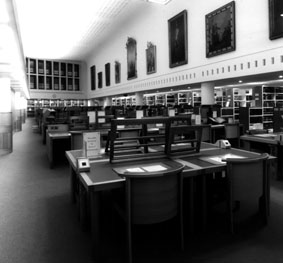
Right:The OIOC reading room is a double height space allowing paintings from the collection to be displayed on the wall above the 78 readers' desks. There are also 10 carrels, 2 of which are reserved for IDP use. Anyone wishing to view the Stein manuscripts must make a request in advance and will normally be directed first to the microfilms and other facsimiles. Photograph by Irene Rhoden.
Dr. A. F. Rudolf Hoernle, Educ. Dept, Bengal.Principal Calcutta Madrasah Feb 1884, and later adviser to Government of India.
Captain Stuart H. Godfrey, British Joint-Commissioner of Ladak and later Assistant to Resident at Kashmir
Sir George Macartney, Special Assistant for Chinese Affairs, and later British consul-general in Kashgar
H. I. Harding, H. B. M.'s late Vice-Consul, Kashgar
Sir Adelbert Cecil Talbot, Resident Kashmir June 1896
N. Fitzmaurice Esq
Captain G. Sherriff
R.A. F.W.Thomas, Librarian of the India Office 1903-27
Collection Description
Chinese
c. 14,000 scrolls and fragments from Dunhuang, Cave 17 (2nd & 3rd expeditions)
c. 1000+ fragments on paper from other sites including Chinese on Tibetan c.500
c. 3000 woodslips, fragments and shavings
Tangut
c. 4000 fragments on paper
Khotanese
c. 50 scrolls
c. 1600 paper fragments
c. 100 woodslips
Tibetan
c. 1400 fragments on papers
c. 2300 woodslips
Kuchean
c.300
Sogdian
c. 50
Uighur
c.100
Eastern Turkic/Runic Turkic
c. 9
Sanskrit/Prakrit, inc. Brahmi & Kharosthi scripts
c. 1500
Mongolian
26
These are approximate categories only. Some of the manuscripts contain more than one language and some are indecipherable. There are manuscripts on birchbark, leather and other materials. The Stein Collection also includes a few paintings on silk and paper, and various artefacts such as sutra wrappers, paper cuts, and paste brushes. The British Library Prints and Drawings Department has a collection of 11,000 prints, negatives and lantern slides taken by Stein in India, Pakistan Chinese Central Asia, Iran, Iraq and Jordan from 1890s to 1938.
Main Publications
The following is a list of the major catalogues of the material published to date as well as work in progress. Most of the material is also available on microfilm and on the International Dunhuang Project Database. The latter includes full colour images. Work will start this year on the Tibetan woodslips (mainly unpublished) and the Tangut material.
Bailey, H. W., 'Codices Khotanenses', Monumenta linguarium Asiae Majoris, II (1938) Copenhagen.
- Khotanese Texts, 7 vols., Cambridge 1945-85.
- Khotanese Buddhist Texts (Cambridge Oriental Series 3), London, 1951.
Boyer, A. M., Rapson, E. J., and Senart, E., Kharosthi Inscriptions Discovered by Sir Aurel Stein in Chinese Turketan, Part I, Text of Inscriptions discovered at the Niya Site 1901, Part II, Text of Inscriptions discovered at the Niya , Endere, and Lou-lan Sites 1906-7, Part III, Text of Inscriptions discovered at the Niya and Lou-lan Sites 1913-14, Oxford, 1920-29.
The British Library et al., Dunhuang Manuscripts in British Collections (Chinese Texts other than Buddhist scriptures), 15 vols., Chengdu, 1990-.
Burrows, T., A Translation of the Kharosthi Documents From Chinese Turkestan (James G. Forlong Fund, v.xx), London 1940.
Chavannes, E., Les documents chinois découverts par Aurel Stein dans les sables du Turkestan Oriental, Oxford 1913.
Corpus inscriptionum Iranicarum: pt. 2 Inscriptions of the Seleucid and Parthian period and of Eastern Iran and Central Asia:
Vol. 5 Saka, Corpus Inscriptionum Iranicarum, London 1955-. Saka Documents I-IV, H.W. Bailey (ed.) Saka Documents V-VI, R.E. Emmerick (ed.) Text volume, H.W. Bailey Dresden, M. J., 'Khotanese (Saka) manuscripts, a provisional handlist', Varia 1976, (Acta Iranica, 3rd series, 12, textes et mémoires V), Téhéran-Liege 1977.
Giles, L., Descriptive Catalogue of the Chinese Manuscripts from Tunhuang in the British Museum, London 1957.
Hoernle, A. F. R., Manuscript Remains of Buddhist Literature found in Eastern Turkestan, v. 1, Oxford 1916.
La Vallée Poussin, L. de, Catalogue of the Tibetan Manuscripts From Tun-Huang in the India Office Library, Oxford 1962.
Mackenzie, D.N., The Buddhist Sogdian texts of the British Library, Bibliothèque Pahlavi, Téhéran-Liege 1976.
Maspero, H., Les documents chinois de la troisième expédition de Sir Aurel Stein en Asie Centrale, London 1953.
Reichelt, H., Die Soghdischen Handschriftenreste des Britischen Museums: in umschrift und mit übersetzung, 2 vols., Heidelberg 1928-31.
Rong Xinjiang, Yingguo tushuguan zang Dunhuang Hanwen fei fojiao wenxian can juan mulu (Catalogue of the Chinese Non-Buddhist Fragments (S.6981-13624) from Dunhuang in the British Library), Shin Wen Feng Printing Co.,Taipei 1994.
Sims-Williams, N., 'The Sogdian fragments of the British Library' Indo-Iranian Journal 18 (1976), pp. 43-82.
Sims-Williams, N. & James Hamilton, Documents turco-sogdiens du ixe-xe siècle de Touen-houang, Corpus Inscriptionum Iranicarum, London 1990.
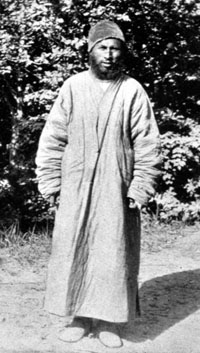
Left:Photograph of Islam Akhun taken by Stein in 1900. The British Library, OIOC.
Skjaervo, P.O., Catalogue/concordance of the Khotanese manuscripts in the British Library, British Library, forthcoming.
Stein, M. A., Ancient Khotan: Detailed Report of Archaeological Explorations in Chinese Turkestan, 2 vols., Oxford 1907.
- Serindia, Detailed Report of Explorations in Central Asia and Westernmost China, 5 vols., Oxford 1921.
- Innermost Asia, Detailed Report of Explorations in Central Asia, Kan-su and Eastern Iran, 4 vols., Oxford 1928.
Takeuchi, Tsuguhito, Old Tibetan Manuscripts from Eastern Turkestan in the Stein Collection of the British Library (Bibliotheca Codicum Asiaticorum II), 2 vols., The Centre for East Asian Cultural Studies for UNESCO, The Toyo Bunko and The British Library 1997-.
Wang Jiqing, 'Notes on the Photographs of Documents and Manuscripts from Sir Aurel Stein's Fourth Central Asian Expedition Preserved in the British Library', British Library Journal Spring 1998.
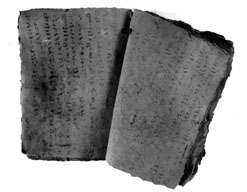
Right:One of Islam Akhun's forged books in a made-up script. The British Library, OIOC, Or.12380
Forgeries
The British Library collection also includes one group of documents (see example above) purchased by George Macartney in Kashgar in the 1880s and 1890s which are forgeries in a made-up language, produced by Islam Akhun (below) and his associates and sold to both the British and Russian consuls at this time. In 1900 Stein spoke to Islam Akhun and managed to get him to admit to the deception. In addition, it is believed by many scholars that some of the 600 or so scrolls bought by Stein on his 3rd expedition in the town of Dunhuang and also at Ganzhou to the east are also forgeries. These are currently being examined.
Dunhuang Manuscripts in the Taipei National Central Library
Introduction
The planning department of the National Library, formerly known as the National Central Library, was founded in Nanking in 1933. During the Sino-Japanese War it had to move west to Chongqing and was formally established there in 1940. It moved back to Nanking after the war and from the end of 1948 to the beginning of 1949 its rich and valuable collections followed the Nationalist government to Taiwan. In 1955 it was formally re-established in Taipei. The new building was completed in 1986 on South Zhongshan Road, Taipei. The most important and valued collection is of Chinese rare books, comprising about 125,000 volumes. As for Dunhuang manuscripts, the Library has a collection of 144 items. These comprise 155 separate scrolls, and are catalogued under the Library's Special Collections. This paper offers an introduction to this collection and relevant discussion, its provenance, characteristics, arrangement and preservation in the Library.
Provenance
Many of the Dunhuang scrolls were acquired from Ye Changchuo and came from Li Shengduo's collection. Ye Changchuo (1881-1968) was from Fanyu in Guangdong Province. During the Japanese War he took part in the search for ancient books and, apart from being responsible for purchasing antiquarian books from Hong Kong, he was also in charge of the important matter of the transport of valuable items from Shanghai to Hong Kong. In a manuscript about his collection he writes: 'Dunhuang fragmentary scrolls were acquired by Liu [Yanshen], Li [Shengduo], and He [Zhenji]. Mr He died first and, apart from those manuscripts given to his friends during his lifetime, I have heard that his collection went to Li. The Li and Liu collections comprise many scrolls of known sutras but there are also some fragmentary texts which are difficult to identify. Mr Li and Mr Liu have both died in recent years and their collections were divided and dispersed. A couple of hundred items were purchased by the National Central Library following my recommendation. I have heard that about a hundred sutra scrolls from Mr Liu's collection went to Zhang Zihou, a relative of his. Mr Li's collection was also divided and sold, and it is now not possible to reconstitute it.'[1] Apart from these, there are also those purchased from Ye Changchuo's own collection.[2] As for the scrolls purchased from Li Shengduo's daughter, because neither Li's seals, colophons or any other distinguishing features are to be found on them, they are problematic. But because these scrolls show seals and colophons of Xu Chengrao and Yuan Kewen, then they can be verified.[3] The contemporary records and reports of purchases show that the manuscripts acquired in its early years by the Library were most probably purchased from Shanghai, Hong Kong, Beijing, Nanjing and other places following the Sino-Japanese War.[4] Once in Taiwan, the Library also bought some items from Zhang Boqian among which were Tang dynasty Dunhuang scrolls.
Characteristics
The manuscripts date from the Six Kingdoms to the Five Dynasties period, with the majority from the Tang. Apart from four Buddhist Tibetan scrolls and three copies of the Daojing, all the rest are Chinese Buddhist texts. One has printed Buddha images but the remainder are all manuscripts. There are 26 with colophons: among them are seven which are clearly dated and 20 which name the scribe, the maker or the donor. Three contain seals of the original collector, two contain Empress Wu Zetian characters and three have phonetic notation at the end. There are only 13 scrolls with texts which are not included in various versions of the Tripitaka, and one which is not in the Daoist Canon. In his preface to 'Dunhuang Scrolls in the National Central Library', Wu Qiyu says that perhaps there are some scholars who believe that 'the collections in Taipei consist of many frequently seen Buddhist texts, and outstanding examples are few, but all are forgeries', but then adds an explanation. After the Japanese War, the Library received ancient Japanese manuscripts and several of them mistakenly found their way into the Dunhuang collection. Apart from the question of whether Li Shengduo collection contained fakes, certain scholars therefore believed the forgers did not make the actual manuscript themselves but simply added false colophons or inscriptions.[5] This can be seen from a comparison of the collection with those in Paris and London.
Ordering
A Catalogue of the Rare Books in the National Central Library was published in 1957 by Zhonghua Publishers in Taipei in which the Dunhuang scrolls were included under 'Buddhist texts'. There were revised and expanded editions in 1967 and 1986. In addition, in 1968 Professor Pan Zhonggui published 'Titles of Dunhuang Scrolls in the National Central Library'.[6] In 1973 my colleague, Li Qingzhu, wrote 'Guoli Zhongzheng tushuguan suozang Dunhuang juanzi jiao du luan ji', and distributed the typescript among his colleagues and friends. In it he noted the paper colour, margins and guidelines, number of panels, whether beginning and end are complete, incipit, size, differences and similarities with other texts in the collection and in the Taisho and, finally, a concordance to theTaisho and other Dunhuang manuscripts, so greatly aiding the work of scholars. In 1975, Pan Zhonggui made a collection of all the titles and it was published in Dunhuangxue.[7] The Library started to microfilm the collection in the early 1970s thus making it possible for scholars to read them, and also thereby avoiding overuse of the originals so extending the manuscripts' life. By 1976, Taiwan Shimen Library Co. published a complete facsimile of the collection. In six volumes, Guoli Zhongyang tushuguan zang Dunhuang juanzi, can be called a pioneering work.
Conservation
The Library has naturally been very cautious when it comes to the preservation of its rare books. This was seen after the move to the new library building in 1986 when all the existing facilities for book storage and security were modernized. The rare books storage area is now equipped with heat and humidity controls, keeping the temperature below 20' C and the humidity between 50-60%. Because ultra-violet light makes it easier to see the faded colour and yellow dye on the paper of these collections, and also to distinguish changes in the brittleness of the paper, such lighting has been installed in appropriate areas. Apart from this, specialist restoration expertise has been developed with responsibility for ancient documents with insect and other damage and fragile paper and such manuscripts are backed with a sheet of lining paper. But when it comes to the Dunhuang scrolls, because they are so old their paper has special characteristics. It is also hand-made, and therefore we have to pay even more attention to find suitable paste and backing paper. We must not act rashly or hastily. At present, the preservation environment is relatively good and even though it is not possible at present for these documents to undergo restoration their condition is not deteriorating.
Conclusion
The Dunhuang scrolls are primary research material for all aspects of the history and literature of ancient China. From the viewpoint of the Library it does not matter where they come from or whether they are genuine or forged, because for this group of manuscripts their preservation is the highest priority. The Library welcomes visits from colleagues with knowledge in this field and hopes to build co-operation to accelerate research into the preservation of Dunhuang materials.
Lou Kamtong is Head of Special Collections at the National Central Library, Taipei. Translated by Susan Whitfield. A longer version of this paper will be published in the forthcoming volume, Dunhuang Manuscript Forgeries (British Library Studies in Conservation and Science: III), London 1999 (details in next newsletter).
Notes
1 Su Ronghui, Dunhuangxue gaiyao (Outline of Dunhuang Studies), Zhonghua yeshu weiyuanhui, Taipei 1964, p. 8.
2 Pan Zhonggui in 'Guoli Zhongyang Tushuguan suozang Dunhuang juanzi tiji' writes: 'I enquired of the Library Director, Professor Qu Penghuang (Wanli) and the former Director, Jiang Weidang (Fuzong), whose understanding was that most were from given from the collections Li Muzhai's (Shengduo) daughter and Ye Yuhu (Changchuo) after the Sino-Japanese War.' (Dunhuangxue 2 (Dec. 1972)). But see the paper by Rong Xinjiang in the forthcoming forgeries volume.
3 See the paper by Chang A-tsai in the forthcoming forgeries volume.
4 For example, no. 118, Jinguangming zui sheng wang jing, has a handwritten catalogue note: 'Purchased after the War'; no. 65, Miaofalianhuajing, has the note: 'Purchased in the capital on the 10th May ,1937'; under Pan's inscription to no. 50, Banruopoluomijing, is the comment: '...in no. 3 box from the Library sutras, and written on the wrapping paper: "Purchased by the Library's Director in Beiping [Beijing], on 7th September, 1935."'; in the report of his Hong Kong purchases dated 4th December, 1941 and published in Guoli Zhongyang Tushuguan guankan 16.1 (April 1983), p. 99, Ye Changchuo wrote: 'recently someone came with Dunhuang scrolls for sale, among which were very many fine examples, and I therefore purchased them. The 30 items cost exactly 2000 Hong Kong dollars.'
5 Op. cit. n.5
6 Xinyabao 8.2.
7 Dunhuangxue 2 (Dec. 1972)).
Dunhuang Manuscripts at Academia Sinica, Taipei
Tu Cheng-sheng
Soon after its founding in 1928, the Institute of History and Philology (IHP) at Academia Sinica established a Dunhuang documentary research team devoted to the collation of Dunhuang materials with an eye to facilitate historical and textual studies. In the following years, the Fu Ssu-nien Library of IHP acquired 49 Dunhuang scrolls. Among them the Mahaparinirvana-sutra (Daboniepanjing, one volume extant) and Fahuayiji (one volume) were from Wu Baohui's collection as shown by his seal. Another scroll, the Mahapratisaravidya-dharani ( Suiqiujide dazizaituoluoni shenhou, one volume) has two colophons in three pages by the original collectors: two pages by Xu Chengrao and the other by Wu Boquan. These Dunhuang materials are now stored in excellent conservation conditions in the Rare Books Room in the Fu Ssu-nien Library, under the supervision of specialist restorers to ensure their longevity. To avoid damages caused by frequent usage as well as to provide speedy access to researchers, the "Project for Rarebooks on CD" was initiated in 1988, and now all the Dunhuang scrolls are digitized in CD storage. Although the Dunhuang manuscripts are not listed in the Rarebooks Catalogue published by IHP in 1968, researchers can turn to the web page newly launched by the Fu Ssu-nien Library to read a list of the entire Dunhuang holdings. The step-by-step access to the web page is :
1. go to the homepage of Academia Sinica
2. click on "Services Library" at top
3. click on the first item "Academia Sinica Library Online Catalog,"
4. type "chinese" to login, type "b" for Big5 Chinese PC, then type "y" for yes
5. type "s" for subject
6. type (in Chinese) 'Dunhuangjuan', and there you are. For research purposes, readers can apply for permission to consult the originals and obtain reproductions from the CD. It is hoped that a separate web page will soon be assigned to the Dunhuang materials, so that researchers across the world can read the manuscripts in full text images via the Internet and prior authorization.
Professor Tu Cheng-sheng is Director of the Institute of History and Philology, Academia Sinica, Taipei.
Note: There are also two Dunhuang scrolls in the History Museum in Taipei: a Dabanniepanjing (Mahaparanirvanasutra) and a Lotus sutra. They have been studied by Jin Ronghua ('Taibei Guoli Lishi Bowuguan cang Dunhuang juanzi ba' in Huagang foxue xuebao 12 (Mar. 1980), pp. 269-70). (Details from Cheng A-tsai whose paper in the forthcoming volumes on Dunhuang forgeries provides an overview of the Taipei collections.)
Publications
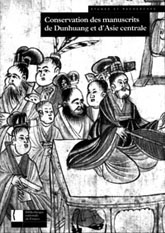
Conservation des manuscrits de Dunhuang et d'Asie centrale
sous la direction de Monique Cohen
Conference papers from the second IDP conference organised by the Bibliothèque nationale de France and held at Paris and Chantilly 7-9 February 1996.
172 pp., 56 ills (b&w)
FF290, Euro35.06, p&p in France: FF35 + FF5 for each additional copy;
Outside France: FF45 + FF10 for each additional copy.
Order from:
Editions de la Bibliothèque nationale de France
58 rue de Richelieu
75084 Paris Cedex 02 France
Tel: +33 1 4703 7521
Fax: +33 1 4703 8172
Email:commercial@bnf.fr
Handbook to Stein Collections in the UK
Helen Wang (ed.) (British Museum Occasional Paper No. 129)
This handbook aims to serve as a finding list for the collections of objects, manuscripts and archives of correspondence that are associated with Sir Aurel Stein's (1862-1943) visits to India, China, Iran, Iraq and Jordan between the 1890s and 1938. In the UK, the collections are now scattered in various organisations in London, Oxford and Cambridge. The entries have been written by the curators, librarians and archivists who work directly on the Stein collections, and the information is arranged in terms of collection history, collection description, publications, accessibility and contact details. A4, 66 pp., GB£7.50, p&p in UK: GB£1.90; overseas surface mail add 15% of order value,
Multiple orders and airmail rates available on request.
Order from:
The Marketing Executive
The British Museum Press
46 Bloomsbury Street
London WC1B 3QQ UK
Tel: +44 171 323 1234
Fax: +44 171 436 7315
Cheques in GBP payable to 'British Museum Company' or quote credit card number and expiry date.
Sir Aurel Stein Bibliography
Istvan Erdeley (ed.) with contributions by Laszlo Bardi and Miklos Erdy
(Arcadia Bibliographica Virorum Euritorum, Fasciculus 17) Eurolingua/Eurasian Linguistic Association, Bloomington, Indiana 1999
64 pp. US$26 (pb).
Available from: Eurolingua, PO Box 10, Bloomington, IN 47402, USA
Manuscripta Orientalia
Note from the Editorial Board
We are glad to inform you about the end of the transitional period caused by the death of our Finnish distributor of Manuscripta Orientalia and financial collapse in Russia. It was not an easy time for us and we are happy that we were able to fulfill all our obligations. We would like to thank you for your support and inform you that we are planning to publish in the nearest future the electronic version of our journal supplying it with dozens of new color illustrations related to the articles.
Please, visit our web-site at: http://orient.thesa.ru Central Asia Resource News
The February issue can be located via NEWS at: http://home.iSTAR.ca/~jmenzies
Other Projects
Merit, Opulence and the Buddhist Network of Wealth
This is an interdisciplinary, cooperative project sponsored by Northwestern University, Evanston, Illinois and the Dunhuang Research Academy. The goals of the project, made possible with a generous grant from the Henry Luce Foundation, are two fold. The international research team will address 10th century art and culture examining the ways in which merit-making activities in temples impacted on the material culture of western China.
The dramatic structural shift in the arts industries during the 10th century occurred when demands on workshops from lay patrons prompted a professionalization of craft production. Fieldwork will be conducted this summer at Dunhuang in three regions of Sichuan. Secondly, caves will also be documented in new, 3D computer models developed with the Dunhuang Research Institute. These models will be accompanied by a database of information on caves crucial to the project.
For further information contact:
Asst Professor Sarah E. Fraser
email:s-fraser2@nwu.edu
Site URL:http://court.it-services.nwu.edu/dunhuang/Merit/
Virtual Dunhuang Art Cave
A site developed by the Artificial Intelligence Institute of Zhejiang University, Hangzhou, China and the Fraunhofer Institute for Computer Graphics, Rostock & Darmstadt, Germany . The site provides a virtual walk through the Dunhuang caves with some historical context on the caves and the area. Although not yet completed it is possible to get guest access.
For further detials contact:
email:sybille@rostock.igd.fhg.de
Site URL: http://www.egd.igd.fhg.de/~dunhuang/welcomeE.html
Conferences
MONGOLIAN AND TIBETAN HISTORICAL SOURCES
COMPUTER APPROACHES
Institute of Oriental Studies
Russian Academy of Sciences Orientalists' Society
Orientalist Information Centre Eurasian Oriental Server
14-16 July 1999
Moscow, Russia
Items under discussion:
Electronic editing, describing and systematising of Mongolian and Tibetan manuscripts and inscriptions, fine arts masterpieces, folklore texts and artefacts, etc. Discussion of theory, methods and technology of creating electronic catalogues and databases of Mongolian and Tibetan texts, their keeping and handling, also exchanging electronic copies of these texts and promoting long-distance access to them.
If you wish to take part please send the following details:
Given Name:
Family Name:
Institute/Organisation & Position:
Title of your presentation:
Postal address:
Tel/Fax & email:
AV equipt required for your presentation:
Please send these details and an abstract of your presentation (200-300 words) to:
Email: postmaster@orient.ru or ivran@glasnet.ru
Fax: +7 95 9257788
Lists of participants and presentations will be placed on the Eurasian Oriental Server (EAOS):
http://www.orient.ru
Dimitry D. Vasilyev
Vice-president
Orientalists' Society of the RAS
Tel: 7 95 9285764
Email: dmivas@glas.apc.org
LANGUAGE AND CULTURE MAINTENANCE IN THE ALTAIC WORLD
Permanent International Altaistic Conference (PIAC)
42nd Meeting
22-27 August 1999
Prague, Czech Republic
For details contact:
Secretary General, PIAC
Goodbody Hall
Indiana University
Bloomington
Indiana 47405, USA
Fax: +1 812 855 7500
Email: sinord@indiana.edu
THE INTERNATIONAL ASSOCIATION OF BUDDHIST STUDIES (IABS)
XIIth Conference
23-28 August, 1999
Lausanne, Switzerland
For details contact:
XIIth IABS Conference
Dept. of Oriental Languages and Cultures
University of Lausanne
B.F.S.H. 2
CH-1015 LAUSANNE
Switzerland
Fax: +41 21 692 3045
Email: iabs99@orient.unil.ch
WWW: http://www.unil.ch/orient
DUNHUANG 2000
The International Academic Conference on the Centenary of the
Discovery of the Dunhuang Manuscript Cave (No. 17)
21-25 June, 2000
Capital Normal University, Beijing, China
For details contact:
Hao Chunwen
Dept. of History
Capital Normal University
BEIJING 100089
The People's Republic of China
Tel: +86 10 6890 3561
Fax: +86 10 6890 2315
Email: Haochunwen@ihw.com.cn
OR Haocw@mailhost.cnu.edu.cn
DUNHUANG 2000
INTERNATIONAL CONFERENCE ON DUNHUANG STUDIES
August, 2000
Dunhuang, China
The conference is scheduled to last six days, the first four days for papers and discussion and the last two days to include visits to the Mogao caves, Yulin caves, West Qianfodong, Yumen Pass and the Han dynasty Great Wall. Spaces are limited to 170 delegates. Participants will be expected to pay a registration fee (which includes local travel for the cave visits), travel to and from Dunhuang, accommodation and other expenses. Further details will be sent with the second announcement in August.
For details contact:
Mr Zhang Xiantang
Assistant Secretary General
Commission of Academic Research
Dunhuang Research Academy
Mogaoku, DUNHUANG 736200
The People's Republic of China
Tel: +86 937 886 9027
Fax: +86 937 886 9028
Email: dhbhlz@public.lz.gs.cn
Project News
People
Colin Chinnery and Susan Whitfield presented a joint paper in January 1999 at the joint meeting of the Pacific Neighbourhood Consortium (PNC), Electronic Buddhist Text Initiative (EBTI) and Electronic Cultural Atlas Initiative (ECAI) held at Academia Sinica, Taiwan.
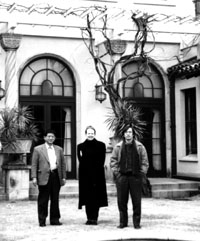
Susan Whitfield went to Kyoto in February at the invitation of Kyoto University Institute for Research in Humanities (Jinbunken) to talk with Professors Katsumura Tetsuya and Takata Tokio (see left) on the International Dunhuang Project and Chinese characters on the web as part of the Institute's project, 'Chinese characters on the Internet', funded by a grant-in-aid of the Japanese Ministry of Education. Thanks are owing to my hosts for such an enjoyable and interesting visit and we look forward to future collaboration.
Sponsors
During her visit to Taiwan, Susan Whitfield visited the Chiang Ching-Kuo Foundation for International Scholarly Exchange, being hosted by the President Li Yih-Yuan, Vice President James Chiang and Secretary Mrs Yu Shufen. She also met with Harold H. C. Han, President of the Himalaya Foundation. The Himalaya Foundation has also generously provided funds through a joint grant with the Chiang Ching-Kuo Foundation. The Project relies on external funds and we remain extremely grateful to all our sponsors. If you would like information on how you can help IDP then please contact us at the address below.
St Petersburg Conference
The 4th conference on the 'Preservation of Dunhuang and Central Asian Material' will be hosted by the Institute of Oriental Studies at St. Petersburg. Details are currently being finalised and further information will shortly be sent out. It is scheduled for Wednesday 8 to Saturday 11 September, 1999 and sessions will be split into four specialist workshops involving practical work and informal presentations, and more formal lectures. The four sessions will take place concurrently. Co-ordinators are:
Paper: Mark Barnard (London) and Anna-Grethe Rischel (Denmark)
Textiles: Barbara Schroter (Berlin)
Wall-Paintings and sculptures: Mr Gabsch (Berlin) & Kira F. Samosyuk (St.Petersburg)
Computer Programmes for cataloguing and digitisation of manuscripts: Erim Rezvan (St. Petersburg)
General presentations will include lectures on conservation and science of interest to all participants.
Call for Berlin papers
During the 'Third International Conference on the Preservation of Dunhuang and Central Asian Collections', held in Berlin last year it was decided to publish the papers as soon as possible. We should like to take the opportunity to thank all participants who have already sent us their manuscripts. We also ask those, who have not yet sent us anything, to do so as soon as possible.
Send papers to:
Dr Hartmut-Ortwin Feistel
Orientabteilung
Staatsbibliothek zu Berlin - Preussischer Kulturbesitz
Potsdamer Strasse 33
D-10785 Berlin
Tel: +49 30 266 2415
Fax: +49 30 264 5955
French papers published Papers from the 'Second International Conference on the Preservation of Dunhuang and Central Asian Material' held in Paris have now been published.
Donation
The Cultural Section of the Chinese Embassy in London made a generous donation of GB£600 towards the project work. It will be used to digitise a group of Dunhuang manuscripts. We would like to take this opportunity to thank them for their interest and support.
Launch of Bookbinding Web Site
Colin Chinnery of IDP has prepared a web site on the history of Chinese bookbinding as shown by the Dunhuang manuscripts. It offers a full survey of all the different types of binding, from whirlwind to pothi, illustrated with both diagrams and photographs of examples. This is the first of many specialist web sites that IDP will be mounting over the next few years.
Sponsor a Sutra
The International Dunhuang Project (IDP) 'Sponsor a Sutra' scheme allows you to help in the digitisation of the Dunhuang manuscripts held at the British Library for as little as GB£50. Just like donors of old, you can arrange for the copying of a sutra and add your name and a message at the end. The difference with donors of the past is that instead of paying a scribe to copy the sutra by hand, you will pay for the sutra to be photographed and digitised. The digitised image with your name and message will be added to the IDP interactive web database where it will appear whenever anyone worldwide accesses the sutra. Several people have already very generously sponsored sutras. You can view these on the database. For example, search under 'Specific Search: Ms. No' for any of the following:
Or.8210/P.8
Or.8210/S.4289
Or.8210/S.5642
Thank you to these pioneering sponsors. If you want to sponsor a sutra yourself the procedure is very simple.
1. Visit the Sponsor a Sutra page and choose a sutra or other manuscript/document that you would like to sponsor from the available Sutra list.
Note: You must sponsor the whole text. In some cases this is only a few lines, in other one sutra takes up the entire scroll which may be over 20 metres long. There is a scale of charges depending on how many images will need to be scanned starting at GB£50 for the first image and GB£25 for each extra image thereafter. You can also sponsor a group of texts, e.g. all copies of a text in the collection. The cost of sponsorship in this case will be estimated separately. There are catalogues of the sutras in the British Library collection. If you would like help or suggestions then please contact IDP.
2. We will confirm the cost of sponsoring the sutra you have chosen and send you details of how to pay. Note: The British Library is a non-profit organisation and therefore in the UK if the cost of sponsorship is more than GB£250 you can use 'GiftAid' which enables us to reclaim tax. If you are a US tax-payer you can also pay through the 'American Trust of the British Library' which enables you to reclaim tax. Details will be sent on request.
3. Once payment is received we will place the sutra/manuscript on a priority list for digitisation In most cases the sutra will be digitised and will appear on the database with your name as sponsor within 8 weeks. For long sutras or at certain times depending on staff availability it may take slightly longer, but we will keep you informed.
